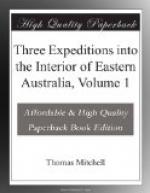RESOLVE TO PROCEED BY LAND.
It was now near five P.M., and the labours of the day had been sufficient to convince me that the course of the Namoi could be much more conveniently traced at that time by a journey on land than with boats of canvas on the water. We pitched our tents; and on plotting my work I found we were distant, in a direct line, only about two miles from Bullabalakit.
December 30.
The cattle from the depot camp arrived at nine A.M., four men having been sent there early this morning to bring them with the carts and horses to the place where we had disembarked.
PROVISIONS DAMAGED.
The tea, sugar, and biscuit, having got wet in the sunken boat, I was compelled to halt this day in order to dry these articles if possible, in the sun, and the heat being very intense, we were tolerably successful. The sugar, in a liquid state, was laid out in small quantities on tarpaulins; the tea was also spread out thinly before the sun, and thrown about frequently—and thus we were enabled, by the evening, to pack it up quite dry in canisters; the whole having lost in weight two and a half pounds. The sugar had crystallised sufficiently to be put up again, without any danger of fermentation. During many days I had anxiously watched the smoky red hot sky for some appearance of rain: no dew nourished the grass, which had become quite yellow, and the river upon which I set my hopes was rapidly drying up. In my tent the thermometer generally reached 100 degrees of Fahrenheit during the day. At length the welcome sound of thunder was heard, and dark clouds cooled the atmosphere long before sunset. These clouds at length poured a heavy shower on the yawning earth; flakes of ice or hail accompanied it, and we enjoyed a cool draught of iced water, where the air had just before been nearly as warm as the blood.
In emptying the water out of the sunken boat we found a crayfish resembling those which I had seen in the freshwater lagoons about Lake George; the remains of this crustacean were also abundant there, at places where water had been but very temporarily lodged.*
(Footnote. A species of Astacus, which, as far as I am aware, comes very close to the common European crayfish.)
PACK UP THE BOATS, AND CONTINUE THE JOURNEY.
We dismantled our boats, packing up the canvas, and in the hollow of a large tree I buried my collection of geological specimens, that we might be loaded as lightly as possible.
December 31.
Quitting this spot at seven A.M. we continued on a bearing of 20 degrees west of north, and passed through a scrub of Acacia pendula, in which grew some eucalypti. At two and three-quarter miles we entered on a spacious open plain which appeared to extend westward to the river, a distance of about two miles. We crossed the more elevated and eastern part of this plain. We next entered a scrub of Acacia pendula, which at




